How to insulate a crawlspace is a trickier question than whether or not to seal it, as discussed in the previous post “The Crawlspace Argument: vented vs encapsulated.”
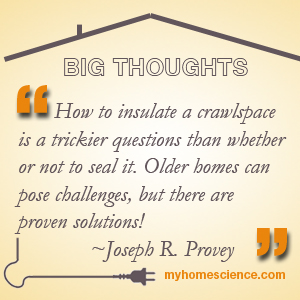
What are your options to insulate a crawl space?
In cold climates, insulating the floor above the crawlspace is often more energy efficient than insulating foundation walls. In the Flagstaff tests, homes with closed crawlspaces and insulated floors used significantly less energy than crawlspaces with insulated walls.
But insulating under floors is not always feasible, especially with existing homes.
Plumbing, ducts, bridging, and electrical get in the way. Furthermore, the insulation must be able to resist the degrading effects of moisture. You can’t simply stuff the joist bays with fiberglass batts and expect long-term performance.
Best closed-crawlspace design
The most comprehensive closed-crawlspace system currently available was developed by Basement Systems, Inc. Called the CleanSpace Crawlspace Encapsulation System, it offers thermal wall and floor insulation and a vapor barrier that seals off the entire foundation wall and dirt floor.
Features unique to the CleanSpace system include:
- Heavy-duty, 20-mil liner for walls and floor. The CleanSpace vapor barrier is securely fastened to the wall (or to insulation) and covers the floor. The 7-ply liner is tough enough to hold up to normal traffic and comes with a 25-year warranty.
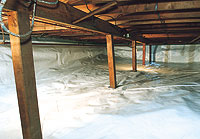
Crawl Space encapsulation is the New Crawl Space Science
- Wall insulation. CleanSpace uses 2-in. rigid board insulation on crawlspace walls that also serves as a moisture barrier. It is infused with graphite particles and lined with a radiant barrier to achieve an R value of 11. Spray foam insulation is often used to seal perimeter framing above foundation walls.
- Floor insulation. A thick, flexible insulating mat may be installed under the CleanSpace liner. In addition to slowing heat loss to the ground, it helps prevent damage to the liner from stone outcroppings and traffic.
- Vent covers. Used to seal off old vent openings, vent covers are made of a thick, durable plastic in several colors. A gasket keeps moist air out and ensures a tight, energy-saving seal.
- Seal for top of masonry walls. An L-shaped molding can be inserted under the sill and over the top of the foundation wall. It is especially useful for sealing the tops of block walls with hollow cores that would otherwise be entry points for moist air. The molding is clear, allowing homeowners and inspectors to check for insect activity. If inspectors require a bigger window, a clear wall liner is available.
- Airtight hatchways. Hatchways are often ill-fitting and therefore a major source of damp humid air (and crawlspace condensation) in summer and cold air in winter. CleanSpace offers two weather-tight entry system, one for above-grade entries and one for below-grade entries.
- Crawlspace dehumidifier. CleanSpace dealers offer a low-profile, heavy-duty, Energy Star dehumidifier designed specifically for crawlspaces. Called the SaniDry CX, the unit includes a high-performance filter that removes particles from the air as small as two microns. The SaniDry has a large reservoir that is typically fitted with a gravity drain to a sump basin or to a small pump that automatically discharges water to the exterior.
The right combination of these tools can greatly improve your home’s performance and air quality. Find a specialty contractor certified to offer these solutions in your area!

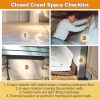

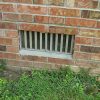
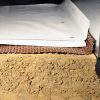
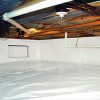

A thick, flexible insulating mat may be installed under the CleanSpace liner. In addition to slowing heat loss to the ground, it helps prevent damage to the liner from stone outcroppings and traffic. I think this product is called terrablock do you know where I can purchase it?
Really am impress of barrier between from above ground ground level ground earth separated from air . Like a bubble a practical business invest ment hands on education a bissness